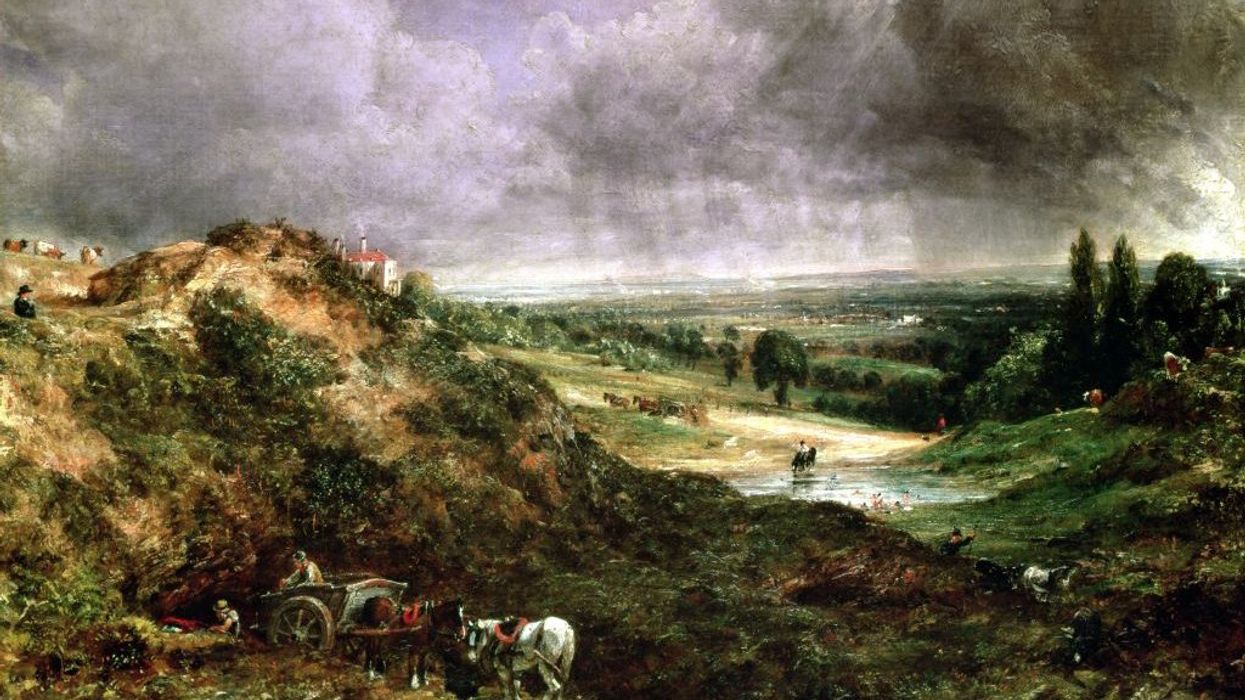
An apparently problematic painting at the Fitzwilliam Museum by John Constable (Photo by Art Images via Getty Images)

A British museum owned by the University of Cambridge recently tried to shake things up, moving around its displays and providing new signage. In an apparent spasm of self-awareness, the director of the Fitzwilliam Museum denied that his new "inclusive and representative galleries" were "woke." This denial, of course, prompted greater scrutiny.
It turns out the university's 208-year-old collection has been reshuffled and augmented in the service of a leftist agenda — one that seeks to repurpose art as propaganda and takes issue with too great a historical appreciation for the country that was England.
Luke Syson, the director of the Fitzwilliam Museum, shared with the campus paper Varsity in 2021 his apparent contempt for European civilization and its fruits, including his institution and the art that hangs therein.
"[The Fitzwilliam] has collections of material that were considered [historically] as belonging to the category of art, as belonging to civilizations that were deemed to be part of the chain of being that led to our own glorious civilization," Syson told the paper. "Despite the fact that European artists were annexing or citing artwork from Africa, it wasn't regarded as being part of the narrative the Fitzwilliam wanted to tell."
Richard Fitzwilliam was an Anglo-Irish nobleman who effectively founded the museum upon his death, conveying his extensive art collection and library to the University of Cambridge.
According to Syson, the narrative embraced by his long-dead benefactor "was a white, European, male-dominated history of art."
"And even if I thought that was acceptable, the rest of the world doesn't and I don't either," added Syson. "What I would really like us to be doing is to make sure that our public spaces are populated in the right way with works of art that we are commissioning and creating now. ... So we are creating an environment, in Cambridge, say, where you don't walk into colleges and see no people of color, no women: we're actually representing people."
Syson has gotten his way.
The Telegraph reported that the museum has dispensed with chronological displays since art history failed to conform with the inclusivity requirements of the day.
Accordingly, a contemporary black artist's painting of an interracial family will serve as an apparent check on the 18th-century painter William Hogarth's painting of a merchant family in a room now called "identity."
Barbara Walker, a contemporary painter and race obsessive, has her work featured in the same room as centuries-old classics.
Other artists, including John Singer Sargent, were shoehorned into exhibits on the basis of their supposed sexual preferences or immutable characteristics.
"I would love to think that there's a way of telling these larger, more inclusive histories that doesn't feel as if it requires a pushback from those who try to suggest that any interest at all in [this work is] what would now be called 'woke,'" said Syson.
Rebecca Birrel, the woman responsible for overseeing the shuffle, said, "Something I've been very conscious of, doing this particular rehang, is that you want to provide the audience with stories without being overly didactic or determining the meaning of artworks. It's just trying to provide possible readings, possible ways in, rather than definitive explanations."
"You want the work to have the space to speak for itself," added Birrel.
Despite Birrel's suggestion that she doesn't want to be didactic and Syson's aversion to being labeled woke, it is clear from the museum's new signage that they have failed on both counts.
The Telegraph noted that the sign for the nature gallery at the museum — where one can find the beloved English painter John Constable's 1820 "Hampstead Heath" — states, "Landscape paintings were also always entangled with national identity."
"The countryside was seen as a direct link to the past, and therefore a true reflection of the essence of a nation," continues the sign. "Paintings showing rolling English hills or lush French fields reinforced loyalty and pride towards a homeland."
"The darker side of evoking this nationalist feeling is the implication that only those with a historical tie to the land have a right to belong," added the sign.
The sentiment echoes that recently expressed by the British leftist environmental outfit Wildlife and Countryside Link, which suggested to parliamentarians in November that "racist colonial legacies continue to frame nature in the U.K. as a 'white space' and people of color as 'out of place' in these spaces and the environmental sector."
The group also claimed that "it is White British cultural values that have been embedded into the design and management of green spaces and into society's expectations of how people should be engaging with them."
British Home Secretary Suella Braverman, the daughter of migrants from Kenya and Mauritius who indicated last year that multiculturalism has failed, responded by underscoring, "No, the countryside is not racist. ... More left-wing identity politics, victimhood & division. Not everything needs to be about race."
The administrators at the Fitzwilliam Museum are evidently of a different mind, and it's not just those green hills and plains that raised generations of Britons that they figure are at issue.
The sign for the "identity" gallery denigrates many of those depicted on the paintings within, claiming that the portraits of uniformed and wealthy sitters were "vital tools in reinforcing the social order of a white ruling class, leaving very little room for representations of people of color, the working classes or other marginalized people."
The Telegraph highlighted that a portrait of the very man responsible for the museum, Fitzwilliam, is among the condemned. The label for his portrait notes that his wealth "came from his grandfather, Sir Matthew Decker, who had amassed it in part through the transatlantic trade of enslaved African people."
Like Blaze News? Bypass the censors, sign up for our newsletters, and get stories like this direct to your inbox. Sign up here!